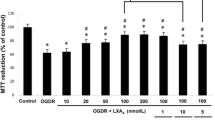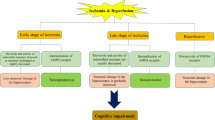Abstract
Oxidative stress is a major pathogenic event occurring in several brain disorders and is a major cause of brain damage due to ischemia/reperfusion. Thiol proteins are easily oxidized in cells exposed to reactive oxygen species (ROS). In the present study, we investigated transient ischemia-induced chronological changes in hyperoxidized peroxiredoxins (Prx-SO3) and glyceraldehyde-3-phosphate dehydrogenase (GAPDH-SO3) immunoreactivity and protein levels in the gerbil hippocampus induced by 5 min of transient forebrain ischemia. Weak Prx-SO3 immunoreactivity is detected in the hippocampal CA1 region of the sham-operated group. Prx-SO3 immunoreactivity was significantly increased 12 h and 1 day after ischemia/reperfusion, and the immunoreactivity was decreased to the level of the sham-operated group 2 days after ischemia/reperfusion. Prx-SO3 immunoreactivity in the 4 days post-ischemia group was increased again, and the immunoreactivity was expressed in glial components for 5 days after ischemia/reperfusion. GAPDH-SO3 immunoreactivity was highest in the CA1 region 1 day after ischemia/reperfusion, the immunoreactivity was decreased 2 days after ischemia/reperfusion. Four days after ischemia/reperfusion, GAPDH-SO3 immunoreactivity increased again, and the immunoreactivity began to be expressed in glial components from 5 days after ischemia/reperfusion. Prx-SO3 and GAPDH-SO3 protein levels in the ischemic CA1 region were also very high 12 h and 1 day after ischemia/reperfusion and returned to the level of the sham-operated group 3 days after ischemia/reperfusion. Their protein levels were increased again 5 days after ischemia/reperfusion. In conclusion, Prx-SO3 and GAPDH-SO3 immunoreactivity and protein levels in the gerbil hippocampal CA1 region are significantly increased 12 h-24 h after ischemia/reperfusion and their immunoreactivity begins to be expressed in glial components from 4 or 5 days after ischemia/reperfusion.





Similar content being viewed by others
References
Fleury C, Mignotte B, Vayssiere JL (2002) Mitochondrial reactive oxygen species in cell death signaling. Biochimie 84:131–141
Cesaratto L, Vascotto C, D’Ambrosio C et al (2005) Overoxidation of peroxiredoxins as an immediate and sensitive marker of oxidative stress in HepG2 cells and its application to the redox effects induced by ischemia/reperfusion in human liver. Free Radic Res 39:255–268
Guedes RP, Bosco LD, Teixeira CM et al (2006) Neuropathic pain modifies antioxidant activity in rat spinal cord. Neurochem Res 31:603–609
Feier G, Jornada LK, Barichello T et al (2006) Long lasting effects of electroconvulsive seizures on brain oxidative parameters. Neurochem Res 31:665–670
Beal MF (1999) Mitochondria, NO and neurodegeneration. Biochem Soc Symp 66:43–54
Sanders SP, Zweier JL, Kuppusamy P et al (1993) Hyperoxic sheep pulmonary microvascular endothelial cells generate free radicals via mitochondrial electron transport. J Clin Invest 91:46–52
Manton KG, Volovik S, Kulminski A (2004) ROS effects on neurodegeneration in Alzheimer’s disease and related disorders: on environmental stresses of ionizing radiation. Curr Alzheimer Res 1:277–293
Rego AC, Oliveira CR (2003) Mitochondrial dysfunction and reactive oxygen species in excitotoxicity and apoptosis: implications for the pathogenesis of neurodegenerative diseases. Neurochem Res 28:1563–1574
Behl C, Moosmann B (2002) Oxidative nerve cell death in Alzheimer’s disease and stroke: antioxidants as neuroprotective compounds. Biol Chem 383:521–536
Heales SJ, Lam AA, Duncan AJ, Land JM (2004) Neurodegeneration or neuroprotection: the pivotal role of astrocytes. Neurochem Res 29:513–519
Kirino T (1982) Delayed neuronal death in the gerbil hippocampus following ischemia. Brain Res 239:57–69
Petito CK, Pulsinelli WA (1984) Delayed neuronal recovery and neuronal death in rat hippocampus following severe cerebral ischemia: possible relationship to abnormalities in neuronal processes. J Cereb Blood Flow Metab 4:194–205
Allen RG, Tresini M (2000) Oxidative stress and gene regulation. Free Radic Biol Med 28:463–499
Baty JW, Hampton MB, Winterbourn CC (2005) Proteomic detection of hydrogen peroxide-sensitive thiol proteins in Jurkat cells. Biochem J 389:785–795
Yang KS, Kang SW, Woo HA et al (2002) Inactivation of human peroxiredoxin I during catalysis as the result of the oxidation of the catalytic site cysteine to cysteine-sulfinic acid. J Biol Chem 277:38029–38036
Woo HA, Kang SW, Kim HK, Yang KS, Chae HZ, Rhee SG (2003) Reversible oxidation of the active site cysteine of peroxiredoxins to cysteine sulfinic acid: immunoblot detection with antibodies specific for the hyperoxidized cysteine-containing sequence. J Biol Chem 278:47361–47364
Rabilloud T, Heller M, Gasnier F et al (2002) Proteomics analysis of cellular response to oxidative stress. Evidence for in vivo overoxidation of peroxiredoxins at their active site. J Biol Chem 277:19396–19401
Brodie AE, Reed DJ (1990) Cellular recovery of glyceraldehyde-3-phosphate dehydrogenase activity and thiol status after exposure to hydroperoxides. Arch Biochem Biophys 276:212–218
Schuppe-Koistinen I, Moldeus P, Bergman T, Cotgreave IA (1994) S-thiolation of human endothelial cell glyceraldehyde-3-phosphate dehydrogenase after hydrogen peroxide treatment. Eur J Biochem 221:1033–1037
Wood ZA, Schroder E, Robin HJ, Poole LB (2003) Structure, mechanism and regulation of peroxiredoxins. Trends Biochem Sci 28:32–40
Chevallet M, Wagner E, Luche S, van Dorsselaer A, Leize-Wagner E, Rabilloud T (2003) Regeneration of peroxiredoxins during recovery after oxidative stress: only some overoxidized peroxiredoxins can be reduced during recovery after oxidative stress. J Biol Chem 278:37146–37153
Hara MR, Cascio MB, Sawa A (2006) GAPDH as a sensor of NO stress. Biochim Biophys Acta 1762:502–509
Schulze H, Schuler A, Stuber D, Dobeli H, Langen H, Huber G (1993) Rat brain glyceraldehyde-3-phosphate dehydrogenase interacts with the recombinant cytoplasmic domain of Alzheimer’s beta-amyloid precursor protein. J Neurochem 60:1915–1922
Burke JR, Enghild JJ, Martin ME et al (1996) Huntingtin and DRPLA proteins selectively interact with the enzyme GAPDH. Nat Med 2:347–350
Koshy B, Matilla T, Burright EN et al (1996) Spinocerebellar ataxia type-1 and spinobulbar muscular atrophy gene products interact with glyceraldehyde-3-phosphate dehydrogenase. Hum Mol Genet 5:1311–1318
Ramos AJ, Tagliaferro P, López EM, Pecci Saavedra J, Brusco A (2000) Neuroglial interactions in a model of para-chlorophenylalanine induced serotonin depletion. Brain Res 883:1–14
Haba K, Ogawa N, Mizukawa K, Mori A (1991) Time course of changes in lipid peroxidation, pre- and postsynaptic cholinergic indices, NMDA receptor binding and neuronal death in the gerbil hippocampus following transient ischemia. Brain Res 540:116–122
Colbourne F, Sutherland GR, Auer RN (1999) Electron microscopic evidence against apoptosis as the mechanism of neuronal death in global ischemia. J Neurosci 19:4200–4210
Dluzniewska J, Beresewicz M, Wojewodzka U, Gajkowska B, Zablocka B (2005) Transient cerebral ischemia induces delayed proapoptotic Bad translocation to mitochondria in CA1 sector of hippocampus. Brain Res Mol Brain Res 133:274–280
Ceballos I, Javoy-Agid F, Delacourte A et al (1991) Neuronal localization of copper-zinc superoxide dismutase protein and mRNA within the human hippocampus from control and Alzheimer’s disease brains. Free Radic Res Commun 12−13:571–580
Delacourte A, Defossez A, Ceballos I, Nicole A, Sinet PM (1988) Preferential localization of copper zinc superoxide dismutase in the vulnerable cortical neurons in Alzheimer’s disease. Neurosci Lett 92:247–253
Hwang IK, Yoon DK, Yoo KY et al (2004) Ischemia-related change of ceruloplasmin immunoreactivity in neurons and astrocytes in the gerbil hippocampus and dentate gyrus. Neurochem Int 44:601–607
Hwang IK, Eum WS, Yoo KY et al (2005) Copper chaperone for Cu, Zn-SOD supplement potentiates the Cu, Zn-SOD function of neuroprotective effects against ischemic neuronal damage in the gerbil hippocampus. Free Radic Biol Med 39:392–402
Hwang IK, Yoo KY, Kim DW et al (2006) Ionized calcium-binding adapter molecule 1 immunoreactive cells change in the gerbil hippocampal CA1 region after ischemia/reperfusion. Neurochem Res 31:957–965
Hwang IK, Yoo KY, Kim DW et al (2006) Ischemia-related changes of glial-derived neurotrophic factor and phosphatidylinositol 3-kinase in the hippocampus: their possible correlation in astrocytes. Brain Res 1072:215–223
Buchczyk DP, Briviba K, Hartl FU, Sies H (2000) Responses to peroxynitrite in yeast: glyceraldehyde-3-phosphate dehydrogenase (GAPDH) as a sensitive intracellular target for nitration and enhancement of chaperone expression and ubiquitination. Biol Chem 381:121–126
Acknowledgements
The authors would like to thank Mr. Suek Han, Seung Uk Lee and Ms. Hyun Sook Kim for their technical help in this study. This study was supported by a grant of the Korean Health 21 R&D Project, Ministry of Health & Welfare, Republic of Korea (A050742).
Author information
Authors and Affiliations
Corresponding author
Rights and permissions
About this article
Cite this article
Hwang, I.K., Yoo, KY., Kim, D.W. et al. Hyperoxidized Peroxiredoxins and Glyceraldehyde-3-Phosphate Dehydrogenase Immunoreactivity and Protein Levels are Changed in the Gerbil Hippocampal CA1 Region After Transient Forebrain Ischemia. Neurochem Res 32, 1530–1538 (2007). https://doi.org/10.1007/s11064-007-9345-6
Received:
Accepted:
Published:
Issue Date:
DOI: https://doi.org/10.1007/s11064-007-9345-6




